The Thai dish known as Khanom Jeen Nam Ya is one of my favorites. It is composed of a distinctive curry sauce with fish spooned over thin rice noodles. The curry-coated noodles are then topped with a variety of fresh vegetables and herbs.
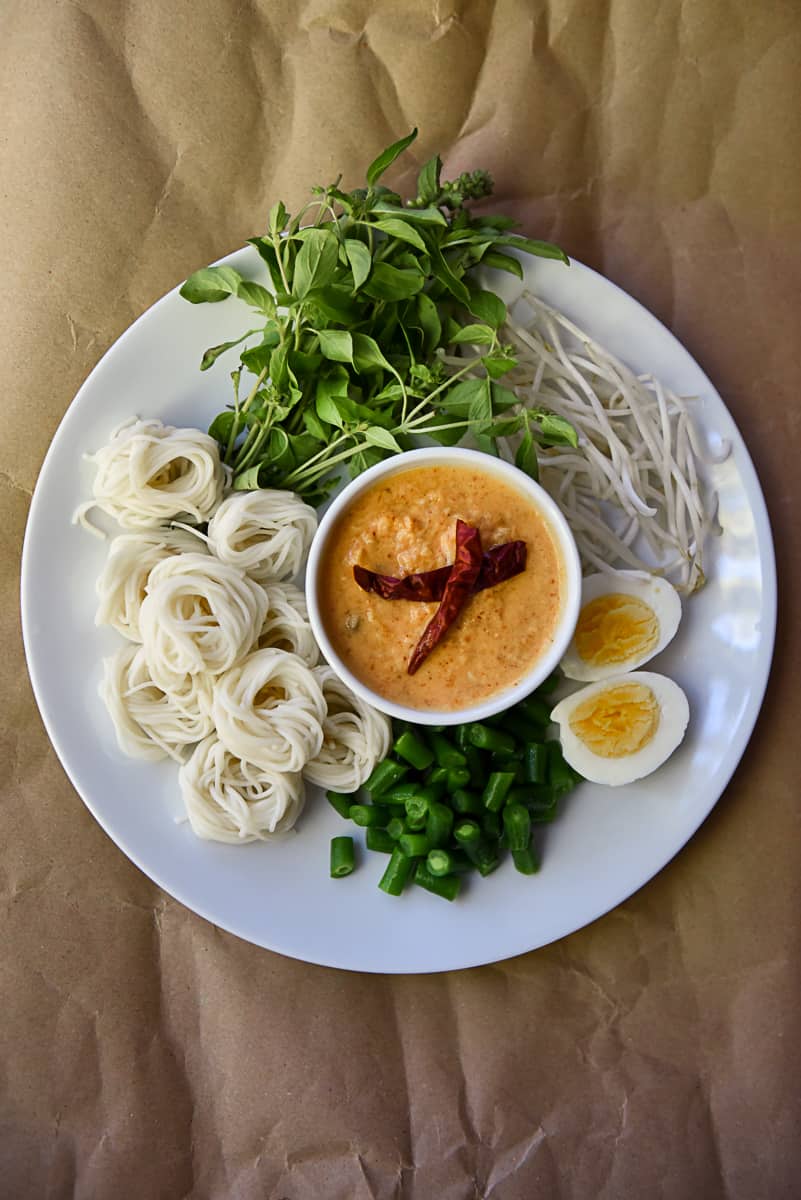
For the most part on this blog, I've stuck to making curries that you can find in Thai restaurants here in the States, including various renditions of yellow, red, and green curries. But now, allow me to introduce you to one of my favorite Thai curries, one that I have rarely seen in American establishments: Khanom Jeen Nam Ya.
Jump to:
What is Khanom Jeen Nam Ya?
Khanom Jeen Nam Ya is a Thai dish composed of thin rice noodles known as Khanom Jeen served with a specific type of curry known as Nam Ya. The curry is spooned over the rice noodles and eaten with an assortment of fresh vegetables and herbs.
There are several different versions of Khanom Jeen Nam Ya served across Thailand. In the Northeast, this curry is made without coconut milk; in the North, it's made with pork; in the South, it's made with dried prawns and turmeric. The version presented here is a central Thai rendition, where the curry is made with a mild-flavored fish and a very distinctive rhizome known as krachai.
With these special ingredients and accompaniments, Khanom Jeen Nam Ya is not a standard choose-your-color Thai curry. However, it's exactly these items that make this dish so special. Here in the States, some of the ingredients require a little work to track down, but the payoff is totally worth it. Here's a rundown of the special ingredients and where to find them:
Special Ingredients
Khanom Jeen Noodles
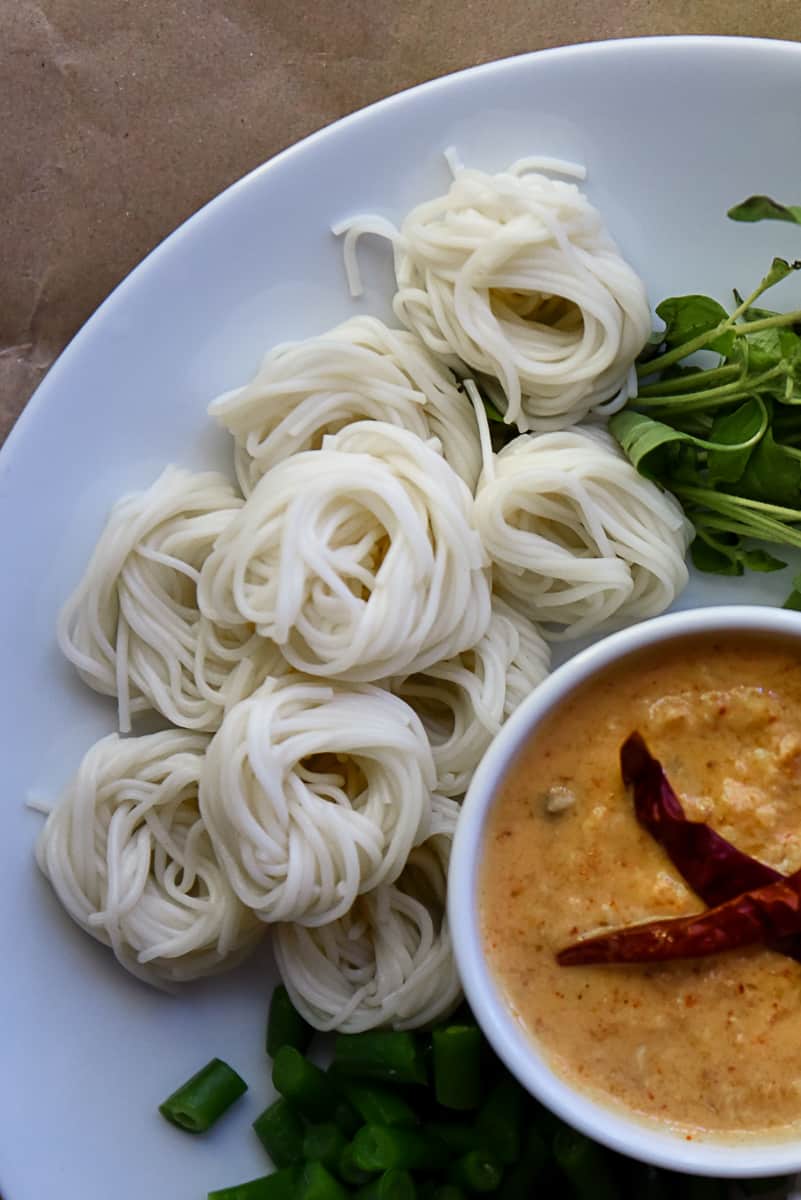
Khanom Jeen noodles are a specific type of thin rice noodles used in Thai cuisine. Historically, they were made from fermented rice that was extruded through a press to make long spaghetti-like noodles in a very labor intensive process. Nowadays, it's more common to find khanom jeen noodles made from regular rice.
Khanom Jeen noodles are often served with a curry or spicy sauce and a variety of fresh vegetables. Nam Ya is one of the most popular curry choices. Khanom Jeen noodles are also used to make a special version of Green Papaya Salad (Som Tam) known as Tam Sua.
Khanom Jeen noodles can often be found in Southeast Asian specialty grocery stores. They are also available online. If you cannot find them locally or don't want to buy them online, Japanese somen noodles are a good substitute. Boil them according to package instructions, rinse in cold water to remove excess starch, and then wrap around your finger into small coils for serving.
Krachai
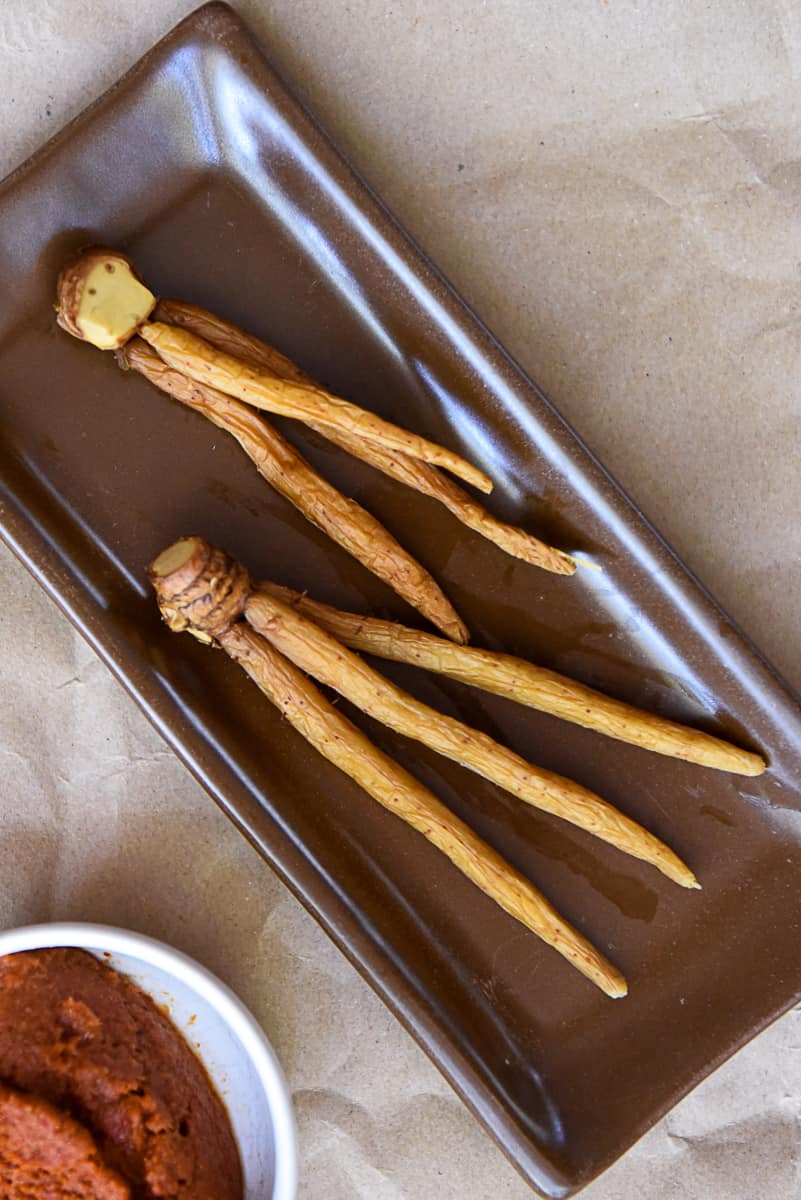
An essential ingredient in the Nam Ya curry paste is a rhizome known as Krachai or Grachai (กระชาย) in Thai. In English, this relative of ginger is known as Fingerroot, Chinese Keys, Wild Ginger, or Lesser Ginger. It has a very robust earthy flavor, with slightly less spice than ginger.
I have not found fresh Krachai in my local markets; however, it is readily available both frozen and brined in Southeast Asian markets. Once frozen, it will last for many months in the freezer. If you are using brined krachai, you should soak it in water for about an hour to remove some of the saltiness. To use, simply cut into small pieces and pound together with the curry paste in a mortar and pestle.
Lemon Basil
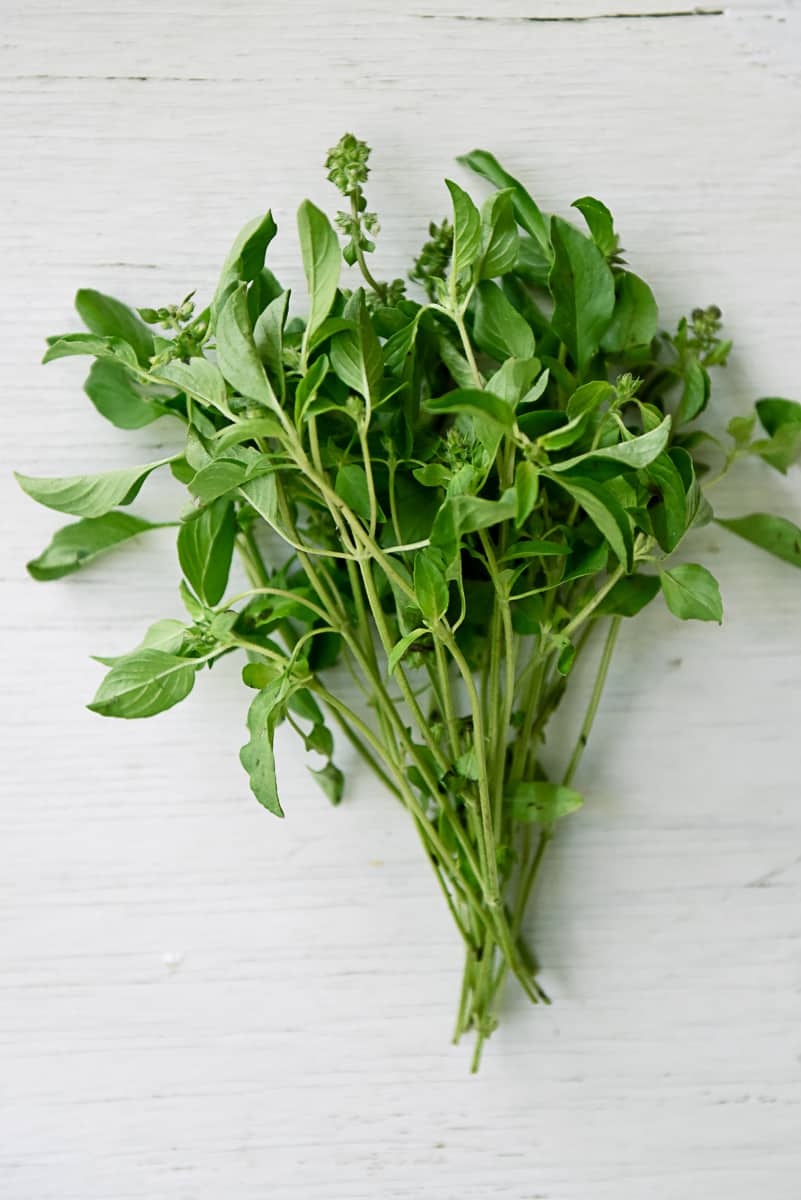
Khanom Jeen Nam Ya is served with an assortment of fresh herbs and vegetables. Of these, lemon basil (bai maeng lak / แมงลัก) may be the hardest to find. This variety of basil has a very distinctive, bright citrus flavor. It has smaller, more fragile leaves than Thai basil. Because of this, lemon basil wilts fairly quickly.
If you are able to find it at your local farmer's market or Southeast Asian markets, I suggest you buy it and make this dish right away! That's what we do 🙂 Another alternative would be to grow lemon basil from seeds. It grows readily with enough sunlight and water, and then you can have this delicious Thai curry noodle dish any time you like.
Other Ingredients
Now that you know about the ingredients that make Khanom Jeen Nam Ya so special, here's a run down of all of the other ingredients necessary to make this dish.
- Red Curry Paste: To make the Nam Ya curry paste, I take a shortcut and simply pound Krachai with a pre-made red curry paste. However, if you'd like to make the curry paste from scratch, recipes are available online. On the flip side, pre-made Nam Ya curry pastes are also available at Southeast Asian markets and online.
- Coconut Milk: Regular canned coconut milk is used to fry the curry paste, and to form the broth of the curry, along with water.
- Water: Water or broth is used to thin out the coconut milk and form more of a soup-like sauce.
- White Fish: Any mild-flavored white-flesh fish will work in this dish. Pomfret and tilapia are two that I've used that work well. The fish can be poached in water or baked in the oven until cooked through. Then it is pounded with a mortar and pestle until no large chunks remain.
- Sugar and Fish Sauce: Sugar and Fish Sauce are added to round out the curry. Depending on the curry paste you use, you may find that you need more or less than what this recipe calls for. Once the curry is done cooking, taste it and adjust with sugar and fish sauce according to your taste preference.
- Fresh Vegetables: In addition to lemon basil, a variety of fresh vegetables are usually served with Khanom Jeen Nam Ya. See below for more details.
- Eggs: Hard boiled eggs are also a common accompaniment.
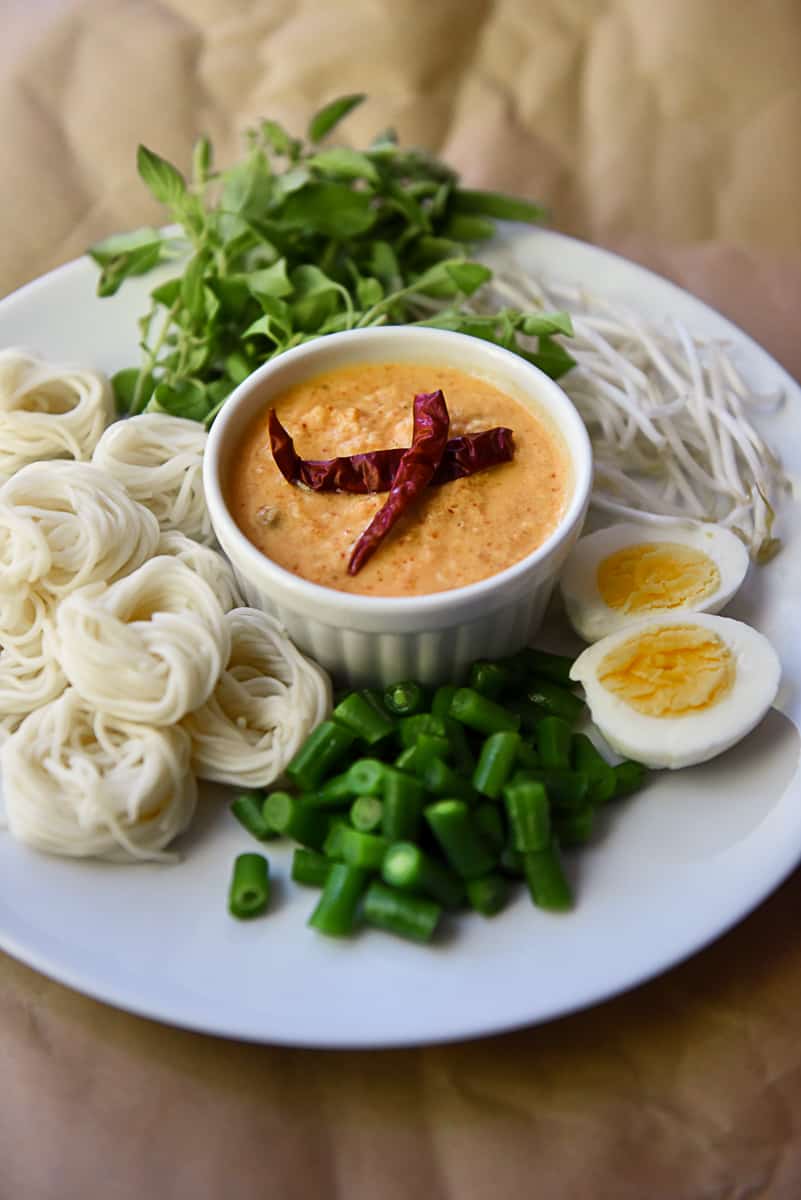
Instructions
- Prepare the Fish: Cook the fish by either poaching or baking until it is tender and flakey. Pound with the mortar and pestle until it is broken down completely, with no large chunks remaining. Set aside while you prepare the curry.
- Prepare the Curry: Pound the Krachai with the red curry paste. Heat ⅓ cup of coconut milk until it separates slightly. Add the curry paste and fry until it is fragrant. Then add the remainder of the coconut milk and water and allow to simmer undisturbed for several minutes. Finally, add the pounded fish. Taste and adjust seasonings with sugar and fish sauce as needed.
- Prepare the Noodles: Boil the noodles according to package instructions, then drain and rinse with cold water. Use your fingers to twirl several noodles into small coils.
How to Serve Khanom Jeen Nam Ya
Once the Nam Ya curry has been made and the Khanom Jeen noodles have been cooked, it's time to assemble all of the accompaniments:
- Bean Sprouts: Can be served raw or quickly blanched
- Lemon Basil: Should be washed, then the whole sprigs plated with the curry
- Fresh Vegetables: Including long beans or green beans, cucumber, bitter melon, cabbage, or banana blossoms. Can be served raw or quickly blanched
- Pickled Mustard Greens: Should be washed and cut into thin slices.
- Hard boiled eggs
Khanom Jeen Nam Ya is often served with the curry, noodles, and accompaniments in separate bowls. When you're ready to eat, place the Khanom Jeen noodle coils on your plate and ladle the Nam Ya curry right on top. Then pile on the accompaniments you'd like. Stir everything together and enjoy!

Each mouthful is filled with flavors of a robust fish curry, fresh vegetables, and a pop of lemon basil. It's absolutely delicious and so different from what is typically served at restaurants here in the States. So if there's one Thai dish that you haven't heard of before but are willing to take a risk and make, I'd encourage you to make this one!
Recipe

Noodles with Fish Curry | Khanom Jeen Nam Ya | ขนมจีนน้ำยา
Ingredients
Fish Curry Ingredients:
- 2 Tablespoons red curry paste
- 2 Tablespoons krachai chopped finely
- 1 cup coconut milk
- 1 cup water
- 1 cup cooked white fish pomfret or tilapia work well
- 1 teaspoon sugar
- 1 teaspoon fish sauce
Noodles and Toppings:
- 10 ounces cooked khanom jeen or somen noodles
- 10 sprigs lemon basil
- ½ cup long beans blanched
- ½ cup bean sprouts blanched
- 2 hard-boiled eggs
Instructions
Prepare the Fish
- This recipe calls for 1 cup of cooked white fish such as pomfret or tilapia. The fish can be cooked by any method that doesn't add additional strong flavor. I typically cook a filet of tilapia in the oven at 350F for 8 minutes, until cooked through but still tender and flakey.
Prepare the Curry
- If you are starting with fresh krachai, wash it thoroughly and scrape the skin off. This step is not necessary for frozen krachai. Cut the krachai into small pieces, then pound with a mortar and pestle until it's broken down completely.
- Add the red curry paste to the mortar and pestle and pound together with the krachai until a smooth paste is formed again.
- Heat ⅓ cup of coconut milk over medium heat until it starts to bubble and separate slightly. Add the curry-krachai paste and stir until it's soaked up all of the coconut milk.
- Add the rest of the thinner coconut milk (⅔ cup) and water to the mixture, stir to incorporate, and then allow the curry to cook undisturbed for a few minutes.
- While the curry sauce is cooking, pound your cooked fish in the mortar and pestle until it's broken down. Add this to the curry and cook for several minutes longer. Taste and then add fish sauce and sugar as needed.
Prepare the Noodles and Accompaniments
- This curry is best when served over khanom jeen noodles with several accompaniments, as follows:
- Khanom Jeen Noodles: Since the real thing can be hard to find, I often substitute Japanese somen noodles. Bring a pot of water to a boil and allow to cook for 3 minutes. Drain and rinse in cool water, then form noodle spirals for serving.
- Hard Boiled Egg: Bring a pot of water to a boil over high heat. Reduce the heat to low, then add your eggs and cook 7 to 8 minutes. Drain, cool in ice water and peel.
- Blanched Vegetables: Bring a pot of water to a boil over high heat. Quickly blanch vegetables such as green beans and bean sprouts before cooling them with cold water.
- Lemon Basil: Wash and serve several sprigs of lemon basil with the dish.
Serve
- Place the noodles, curry, and accompaniments in separate bowls on the table. Diners can transfer noodles to their plate, then top with curry and the accompaniments that they'd like. Mix everything together, or eat the vegetables / herbs between bites of the curry-covered noodles.


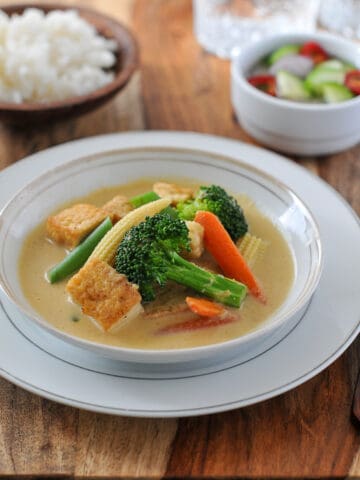
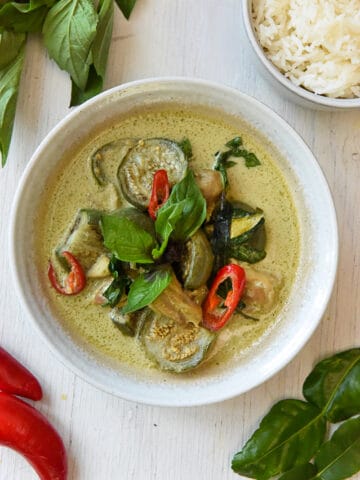

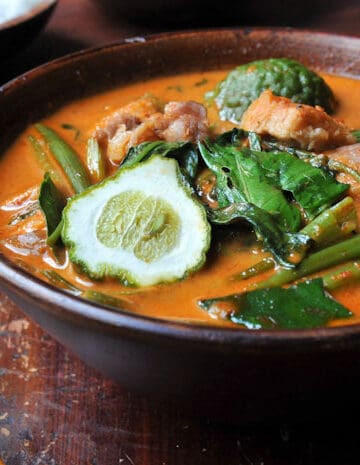
Isadora
I made this while it Thailand as my cousin recommended it to me and it was delicious! I had to substitute the fish for some zero meat but he said it came out almost the same. I was lucky enough to find the Khanom Jeen noodles at a market and I agree that they really make the dish special. Thank you so much for sharing this recipe!
Auspice
Just got back from Thailand and was happy to find your site. I'm making the tea right now and will try this later.
Rachel
Hi Alex - nice to hear that this dish is on a restaurant menu!
Sarah
This looks incredible. I love Thai food but rarely make it because it never comes out the way I remember in Thailand, mostly because I lack a few core ingredients.
Alex
We just put this on the menu at the restaurant where I work! I had trouble understanding the description of the dish before but now I do, thanks!
Noi
I have been craving for khanom Jeen Numya for forver. I will try this recip this weekend.Thanks Rachel!!